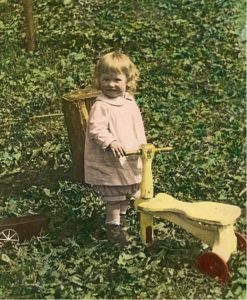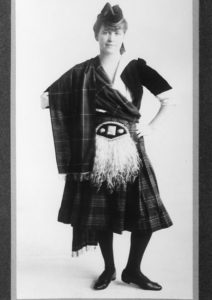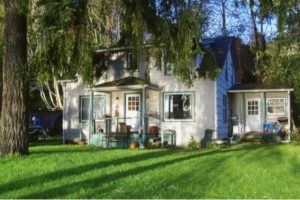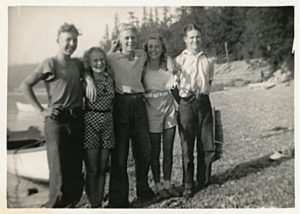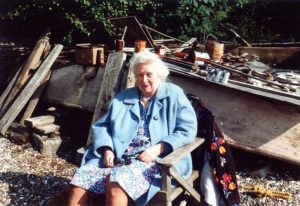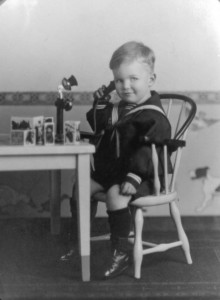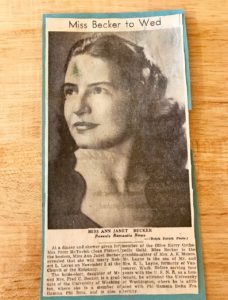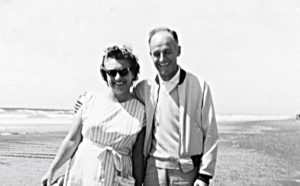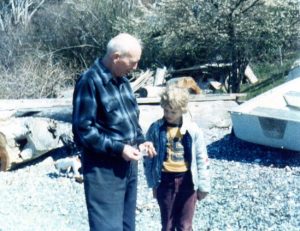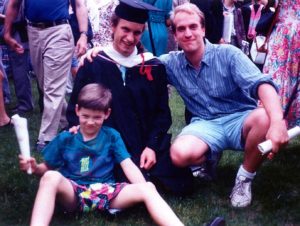Ann Janett Munro
Ann Janett Munro Becker – Granny, GG, Aunt Ann – was a beautiful, intelligent and quietly funny presence. She was born October 29th, 1895 at Crystal Springs, Bainbridge Island, Washington, the fourth child of Janet and Alexander Munro. As a young girl, she had red hair and a sprinkling of freckles. For the first four years of her life the family followed her father to jobs in Victoria, B.C. and elsewhere, returning off and on to their home on Bainbridge Island. Then in 1898 they moved to the Latona area of Seattle while Alexander worked on the construction of Denny Hall on the University of Washington campus. The neighborhood was rural and when a calf wandered off, Alexander found it some blocks away.
Ann’s brother George was born in February 4th, 1899, and the next spring the family moved back to Bainbridge. George Munro told this story at the Bainbridge Historical Museum in 1983:
I was born in Seattle because when they came back from Victoria, why they rented a little house in Seattle waiting for the spring to come so they could go back to the place on the Island. Burt Lindquist, who lived on the shore where the Lindquist float was, told me ‘I remember when you came, George. I was about five years old.’ And I said ‘And how do you remember that?’ Well he said that his father had a little boat, and had run out to bring my folks to shore. It was my mother and father. I had three older brothers and two older sisters. Well I said ‘And what was so exciting about that?’ ’Well, you were in a little blanket.’ And I said, ‘That wasn’t unusual.’ ’No’ he said ‘I was just awful glad to see some other kids coming because there were no kids in the neighborhood to play with.’ Well I said, ‘Was that the thing that impressed you most?’ ’No’ he said, ‘The thing that impressed me most was they shoved a cow overboard.’ You see these little boats had a freight deck and the freight deck wasn’t any higher than this table off the water. …We came ashore at Lindquist’s float and the cow walked to the place, because everybody had to have a cow.
After this big move with six youngsters, Janet and the children stayed in residence on Bainbridge while Alexander traveled to various jobs. Ann grew up on the family farm and went to school at the one-room Crystal Springs schoolhouse, taking the old Point White Trail that traced through the woods and behind neighbors’ homes for a mile or so until it reached the school.
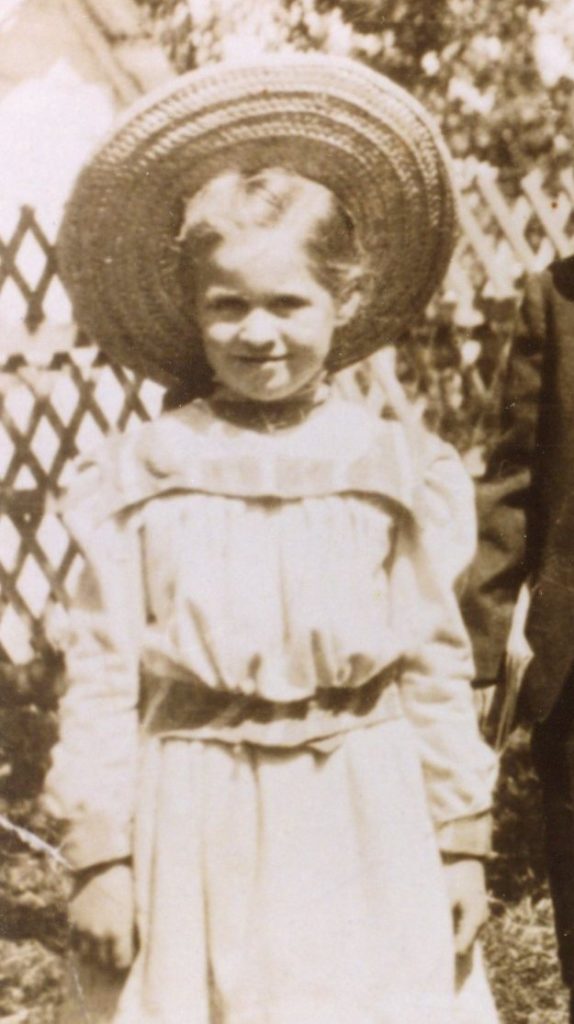
Native Americans from the Suquamish and other tribes paddled by in dugout canoes on their way to the hop fields in Puyallup or spent the summers on the beaches digging clams to sell in Seattle in hand-woven baskets. Many years later Ann recounted this little story:
One day the Chief came to the schoolhouse door, which brought everyone to attention. He pointed to a young prankster who had stolen a basket, handmade by a Suquamish woman. The Chief pointed to the young thief and demanded ‘pifty cent’ be paid in exchange for the basket.
Fifty cents was about the going price for a basket of clams in Seattle.
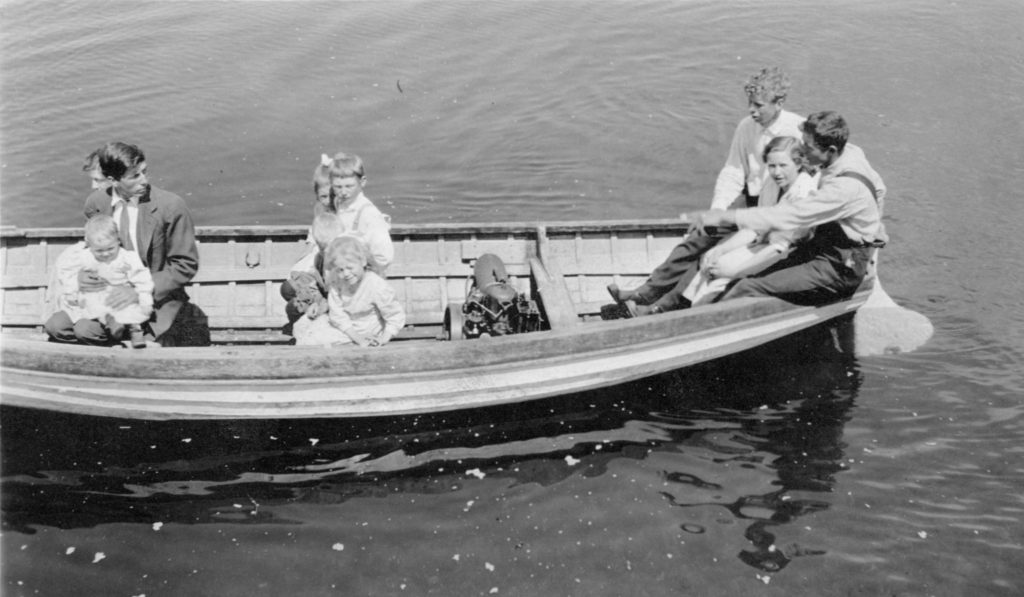
Ten Munro Kids in Duncan’s Launch in 1910.
Lachlan Montgomery installed a shaft log, Gray Marine engine, propeller shaft and propeller, in this life boat. 1st Thwart Seat – Mary, John, James. 2nd thwart seat – Euphemia, George, Gordon & Isabel. Stern Seat – Bill, Ann & Duncan.
Like many of her brothers and sisters, Ann graduated from Queen Ann High School in Seattle. The small steamboats of the Mosquito Fleet were the main form of transportation on Puget Sound, stopping at Gibson’s Landing in front of the Munro home and at numerous other landings along the way. Family legend has it that the Munro kids would ‘take the boat’ to Coleman Dock in Seattle, walk to the counterbalance at the foot of Queen Ann Hill and then take a street car up to the High School. Now and again they would walk up the Hill and spend the nickel fare on candy. In the afternoon they would reverse course for home.
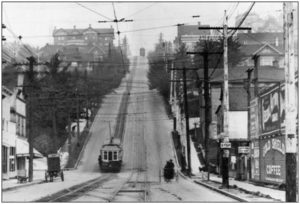
From 1898 until Aug. 10, 1940, streetcars similar to the tram advertising we see today (show here in 1910), ran between upper and lower Queen Anne Hill, aided by a weighting system known as a ‘counterbalance.’ https://www.seattlepi.com/local/article/Piece-of-history-concealed-within-Queen-Anne-Hill-1198180.php#photo-666823.
Ann was a good student and her parents were proud when she went on to secretarial school. By the time the federal census taker came around in early 1920 she was living with a friend on Bush Street in San Francisco and working as a stenographer for a wholesale soap company. Good clean work. About that time she met a dashing young salesman, Frederick C. Becker. He was keenly intelligent with a magnetic personality and beautiful, bright blue eyes.
Fred was the second child of Paul and Emma (Godfrey) Becker. The family lived in West New York, New Jersey, a community on the banks of the Hudson River largely made up of Italian and German immigrants where Paul was the minister at St. John’s Lutheran Church. Fred’s brothers and sisters included Caroline, Paul, Edwin, Boas, Ernst and Ruth. Only Fred, Paul and Ruth lived to adulthood.
After his father passed away in 1916, Fred paid his own way through Wagner College in Rochester, New York, by working on steamboats on the Hudson River (His father also graduated from Wagner when it was the Lutheran Proseminary of Rochester). After college Fred became a salesman (maybe soap?) and his work took him to San Francisco.
Ann and Fred were married in 1920. Ann thought she was marrying an older man and she didn’t realize he was younger until they signed their wedding certificate. The young couple honeymooned at Niagara Falls. Their first home was in New York, but they both found the east coast rigid and formal, and they soon moved to Washington where they would live for the remainder of their lives.
Their son Fred Jr. was born at Crystal Springs on July 19th, 1921.
A while later they moved to a home located at 317 East 52nd Street, near Latona, a short ways from where Ann’s family had lived in 1899. Or, as legend has it, ‘About where Grandad found the calf that got lost that time.’ Then in about ’33 they moved to their home at 2009 Boyer Avenue East (Montlake) where they raised their three children, Freddy, Annie and MaryBelle. All three graduated from Garfield High School and the University of Washington. Fred and Ann built a vacation home at Crystal Springs and visited often.
Ann was quiet, self-contained and practical. She was walking in the city one blustery day; her hands full with an umbrella and other things…when her bloomers fell down. She just stepped out of them and went on her way. She never learned to drive and was content to take the bus wherever she needed to go. She enjoyed people – to a degree. Fred once invited clients over for dinner and Ann reluctantly agreed. A short while later she called him back and said: ‘It just isn’t going to work. I can’t reach the waffle iron.’ They entertained out.
Ann’s kitchen always smelled wonderful. She had a cold storage cupboard on the back porch accessed by a screened opening in the kitchen. Fred was a great gardener and this cupboard was always full of produce, adding their fragrance to the kitchen. If you ever came to Ann’s dining table, there would be Ginger Snaps, Lorna Doons, and tea with milk and honey. In later years it was covered with newspaper clippings, yarn and scraps of fabric. She was quite the seamstress and she taught several of her grandkids how to knit. She was also wonderful at simple drawings and she would write very imaginative letters to her granddaughters. Ann named and fed all the birds and squirrels in her garden, right at the window next to her breakfast nook.
Most of the Munro kids had a strong frugal streak and Ann was no exception. She almost always wore handmade house dresses and as they aged she would put an apron over them, wearing them until they were totally worn out. Like most women of her time and place, she wore layers and layers, starting with a corset. For every wedding or special occasion it seemed she always wore the same purple wool suit. It had a blazer collar and a peplum bodice with a little flair. Ends up she had four or five nearly identical suits hanging in her closet.
Her sense of humor never left her and she could often be heard quietly giggling with her children and grandchildren. During the ’64 presidential campaign, Barry Goldwater’s slogan was ‘In your heart you know he’s right.’ Ann would add ‘But in your gut you know he’s nuts.’
In many ways, Fred was her counterbalance. He was outgoing with a booming, gruff, loud voice. Yet their marriage was loving and tender. She called him Fred and he called her Bunny. Fred read three different newspapers a day and he switched between reading glasses and driving glasses, often putting his reading glasses on top of his head. The house would echo with ‘Bunny, Bunny, Have you seen my reading glasses?’
Fred had a very serious side when it came to business and worship. He was the first member of the family to become a Christian Scientist, perhaps through friends or following a spiritual experience. He studied and became involved in a church near their home, and he held a lifelong commitment to his church.
He was also a very successful business man. The 1951 Seattle City Directory lists him as the Branch Manager of the Great-West Life Assurance Company. He was very active in the Republican Party and ran for Insurance Commissioner at least five times between 1940 and 1960. He never won, ‘…but it was Great for Business.’
In about 1946 the citizens of Seattle elected a panel or committee of ‘Freeholders’ to update and revise the City Charter, and Fred was one of the elected ‘Freeholders.’ The City Charter he helped write is still in use today.
Fifteen freeholders wrote the charter that voters approved on March 12, 1946. They circulated drafts of the charter as widely as possible and invited citizen input. The resulting charter was supported by good-government groups like the League of Women Voters and the Municipal League, as well as labor leaders, community councils, and city leaders including Mayor Devin. It won by a wide margin, winning by 60,251 votes to 25,065 in results published the day after the election. Seattle voters approve new city charter and re-elect Mayor William F. Devin on March 12, 1946. By Kit Oldham. https://historylink.org/File/3560
In 1948 Fred and his brother-in-law, James Munro, traveled to Philadelphia to serve as delegates to the Republican National Convention. James supported Thomas Dewey and Fred supported Senator Robert Taft.
During World War II Fred served on a volunteer civilian safety watch around the port area. He also became intrigued with the idea of growing a Victory Garden. He launched into it full measure and became quite the gardener. He continued to keep a garden until he was quite elderly – as long as he was able.
Fred’s grandchildren remember that his office was on Seattle’s main parade route and they would watch the festivities from his office window. He wore a three piece suit to work every day. Even after he retired, when he would go into town to have lunch with friends, he would wear a three piece suit. His grandchildren would climb up in his lap and start checking his pockets for lifesavers and butterscotch.
Fred loved dogs and they loved him. James Munro had a little dog that would start barking and running in circles before anyone else knew that Fred was headed up the driveway in his old blue car. He was also quite a fisherman. He enjoyed taking his grandchildren fishing on Green Lake, but they had to remember to use the bathroom first . . .‘cause he wasn’t coming in.
Ann and Fred Becker were pillars of the Munro family. They lived their lives with purpose and showcased the finest qualities our family has to offer – integrity, independence, service to community, humility, high standards for themselves and those around them, and a deep love for family. Ann passed away on July 8th, 1984 and Fred followed on April 12th, 1985.
A Little More:
Fred and Anne loved a garden and had a very nice one on Boyer Ave. When I was about 6, Fred called my dad and asked him if he could cut some bean poles for Fred’s garden. Daddy went up in the woods on an old logging road and found some alder seedlings about 2-3 inches thick and 8-9 feet long. Daddy cut them, trimmed them, and bundled them up and tied them to the roof of our old Plymouth. Off we went to Seattle on the ferry and took the bean poles to Fred and Ann. We had a nice lunch and a tour of his garden and yard. About two months later Fred was over on the Island. Daddy asked him how the bean poles were working. Fred and Bunny started to laugh. The beans were not doing so well but the bean poles sprouted and he was growing alder trees in his garden. We all got a good laugh about that.
Ralph Munro
~ ~ ~ ~
I remember a revolving campaign sign that fit on top of the car that rotated in the wind as the car was driven. Mom said that one time she was to meet Dad or Grandpa on a street corner in downtown Seattle during a campaign to go home. But during rush hour (which undoubtedly bears no resemblance to current rush hour in Seattle) some streets became one-way. She seemed to be always on the wrong corner as the car with the rotating sign went whop-whopping along on the other side of the street, the driver frantically signaling for her to go to another corner. But as the streets changed to one-way the car could no longer get to that spot either, but was now, once again whop-whopping in the wrong place. This went on for a painfully long time as the car went around block after block, whop-whopping away, as the one-way signs were put up.
Another story I heard was that a particular niece was getting a bit hard to handle at home. The thought was that if she went to live with Granny and Grandpa they would keep her on the straight and narrow. Grandpa, in particular, was very rigid about what he thought was right and what was not right. So they were going to be a very good influence on this niece. What I heard was that Granny helped the niece sneak out at night, at the very least leaving the back door unlocked so she could get back into the house unannounced late at night.
Bruce Becker
~ ~ ~ ~
If you have photos or a story about Ann or Fred Becker that you’d like to share, please send it to knotfarm@olynet.com.
Chris, Drew & Jeremy (Ann Janett Becker’s Great Grandsons)
